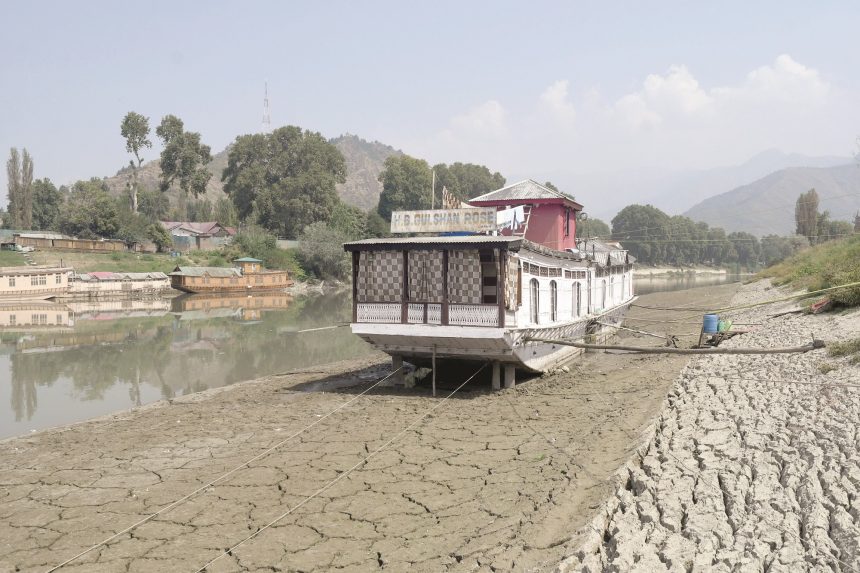The unprecedented heat conditions in Kashmir are a stark reminder of the urgent need to adapt to climate change
Kashmir, known for its picturesque landscapes and cool climate, has not been immune to the global phenomenon of climate change. In recent years, the region has experienced unprecedented heat conditions, challenging the resilience of its inhabitants and infrastructure. This article explores the impact of these heatwaves, particularly on school-going children, and underscores the urgent need for infrastructural development to cope with changing climatic conditions.
THE REALITY OF RISING TEMPERATURES
Historically, Kashmir’s temperate climate has provided a natural respite from the scorching summers of other parts of India. However, recent years have seen a significant rise in temperatures. According to meteorological data, the average summer temperatures in Kashmir have increased by several degrees over the past decade. The heatwaves that were once rare are becoming more frequent and intense, pushing the region into uncharted territory. The impact of this rise in temperature is multifaceted. On one hand, it poses direct health risks, particularly for vulnerable populations such as children and the elderly. On the other hand, it exacerbates existing infrastructural inadequacies, highlighting the urgent need for a systemic response.
VULNERABILITY OF SCHOOL-GOING CHILDREN
Among the most affected by the rising temperatures are school-going children. The education infrastructure in Kashmir, like in many other parts of India, is not equipped to handle extreme heat conditions. Most schools lack basic amenities such as air-conditioned classrooms, adequate drinking water facilities, and proper washrooms. This not only hampers the learning environment but also poses serious health risks.
LACK OF AIR CONDITIONING
The absence of air-conditioned classrooms is a major concern. During heatwaves, classrooms can become unbearably hot, leading to heat stress among students. This can cause dehydration, dizziness, and in severe cases, heatstroke. The inability to concentrate in such conditions also negatively impacts the learning process.
INADEQUATE DRINKING WATER FACILITIES
Access to clean drinking water is essential, especially during hot weather. Many schools in Kashmir lack sufficient drinking water taps, forcing students to either bring water from home or go without. Dehydration is a common issue, which can lead to serious health problems if not addressed promptly.
POOR WASHROOM FACILITIE
Proper sanitation facilities are crucial for maintaining hygiene and preventing heat-related illnesses. However, many schools in Kashmir have inadequate or poorly maintained washrooms, which can deter students from staying hydrated, as they might avoid drinking water to minimize the need to use these facilities.
THE NEED FOR RESILIENT INFRASTRUCTURE
Addressing these challenges requires a comprehensive approach that includes both immediate interventions and long-term planning. The forces of nature cannot be harnessed, but through infrastructural development and calendar adjustments, the region can better cope with the new climatic realities.
IMMEDIATE INTERVENTIONS
- PROVISION OF AIR CONDITIONING: Installing air conditioning units in classrooms should be a priority. While this may be expensive, it is a necessary investment in the health and well-being of students. Alternative solutions like fans and coolers can also be considered for immediate relief.
- WATER SUPPLY ENHANCEMENT: Schools should be equipped with an adequate number of drinking water taps. Installing water coolers and ensuring a regular supply of clean water can help prevent dehydration among students.
- SANITATION IMPROVEMENT: Upgrading washroom facilities is essential. This includes ensuring cleanliness, availability of water, and proper maintenance. Building separate washrooms for boys and girls can also address privacy concerns.
LONG-TERM PLANNING
- INFRASTRUCTURE DEVELOPMENT: Schools need to be designed or retrofitted with climate resilience in mind. This includes constructing buildings with better insulation, ventilation, and materials that reduce heat absorption. Green building techniques can be employed to create a more comfortable learning environment.
- CALENDAR ADJUSTMENTS: Adjusting the academic calendar to avoid peak heat periods can be a practical solution. Shifting summer vacations to align with the hottest months can reduce exposure to extreme temperatures.
- REE PLANTING: Creating green spaces around schools can help mitigate the heat. Trees provide shade and can lower the ambient temperature through transpiration. Landscaping can also include installing shaded areas where students can gather during breaks.
THE ROLE OF GOVERNMENT AND COMMUNITY
The responsibility of implementing these changes does not lie solely with the schools. A concerted effort from the government, community, and private sector is essential.
GOVERNMENT INITIATIVES
The government needs to allocate funds and resources to upgrade school infrastructure. Policies should be enacted to ensure that new school buildings are constructed with climate resilience in mind. Additionally, subsidies or incentives for schools to install air conditioning and other cooling technologies can encourage quicker adoption.
COMMUNITY INVOLVEMENT
Community participation is crucial for the success of these initiatives. Parents, local businesses, and NGOs can collaborate to support schools in upgrading their facilities. Community-driven projects, such as tree planting drives and fundraising for air conditioning units, can make a significant difference.
PRIVATE SECTOR PARTNERSHIP
The private sector can play a role by providing technological solutions and financial support. Partnerships with companies specializing in green building technologies and climate-resilient infrastructure can bring innovative solutions to the table.
CASE STUDIES AND BEST PRACTICES
Looking at examples from other regions that have successfully addressed similar challenges can provide valuable insights.
CASE STUDY 1: RAJASTHAN’S COOL ROOF PROGRAM
In the hot state of Rajasthan, the Cool Roof Program was introduced to combat rising temperatures. By coating roofs with reflective materials, the program has significantly reduced indoor temperatures. A similar approach can be adopted in Kashmir to make classrooms more bearable during heatwaves.
PRIVATE SECTOR PARTNERSHIP
The private sector can play a role by providing technological solutions and financial support. Partnerships with companies specializing in green building technologies and climate-resilient infrastructure can bring innovative solutions to the table.
CASE STUDY 2: KERALA’S GREEN SCHOOLS
Kerala has implemented the Green Schools initiative, which focuses on building environmentally sustainable and climate-resilient school infrastructure. These schools incorporate rainwater harvesting, solar panels, and natural ventilation, providing a blueprint for similar initiatives in Kashmir.
CASE STUDY 3: GLOBAL PRACTICES
Globally, countries like Australia and the United States have implemented heat action plans for schools. These plans include guidelines for reducing heat exposure, providing cooling centers, and ensuring the availability of water and medical facilities. Adopting and adapting these practices can help Kashmir develop a robust response to rising temperatures.
THE PATH FORWARD
Climate change is a global challenge that requires local solutions. For Kashmir, the path forward involves a combination of immediate interventions and long-term planning. Ensuring that schools are equipped to handle heatwaves is not just about protecting the health of students but also about safeguarding their right to education.
By investing in resilient infrastructure, adjusting academic calendars, and fostering community and government collaboration, Kashmir can mitigate the impact of rising temperatures. This approach not only addresses the current challenges but also prepares the region for a future where extreme weather conditions may become the norm.
In conclusion, the unprecedented heat conditions in Kashmir are a stark reminder of the urgent need to adapt to climate change. School-going children, being among the most vulnerable, must be prioritized in these efforts. Through comprehensive infrastructural development and proactive planning, Kashmir can build a more resilient and sustainable future for its students and its communities.
(The author is Social Activist and National TV debater. The Views expressed are his own and can be reached on @[email protected])








